Trimester 3, 2018 ACC707: Auditing and Assurance Services Assignment
VerifiedAdded on 2023/04/23
|16
|3933
|100
Homework Assignment
AI Summary
This assignment analyzes two case studies, Advanced Computer Solutions Limited and Green Machine Limited, to evaluate audit risk and assertions within the context of auditing and assurance services. The student addresses inventory valuation, accuracy, and existence for Advanced Computer Solutions, considering factors like software issues, inventory turnover, and warehouse changes. Substantive audit procedures are proposed to mitigate identified risks, and the application of ASA 701 for communicating key audit matters is examined. For Green Machine Limited, the assignment focuses on property, plant, and equipment (PPE), addressing classification and valuation assertions, including depreciation rates and expense classification. Substantive audit procedures are recommended to address these risks. The assignment emphasizes the importance of accurate financial reporting and the auditor's role in ensuring the reliability of financial statements. The document demonstrates an understanding of audit assertions, risk assessment, and the communication of key audit matters in accordance with auditing standards.
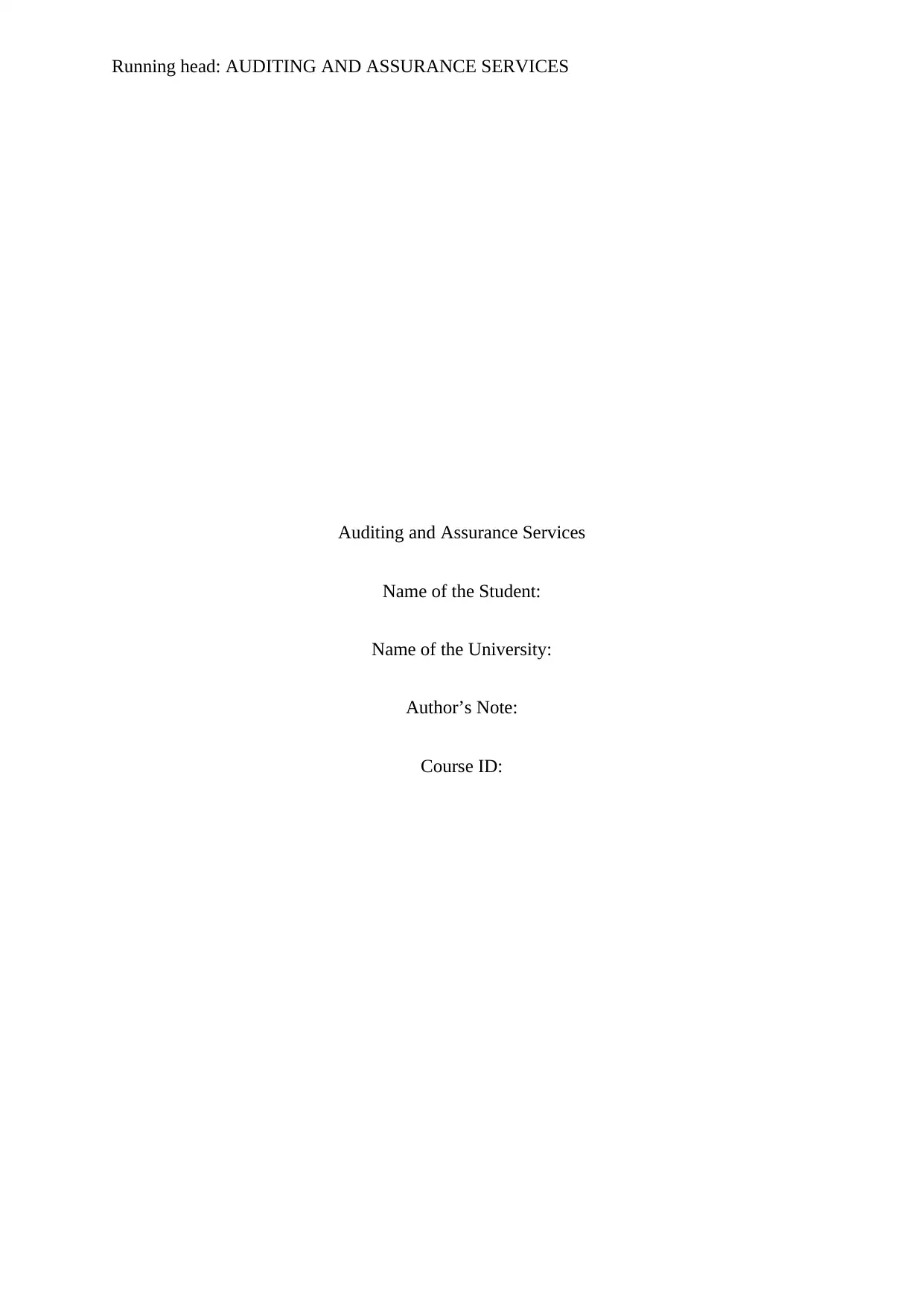
Running head: AUDITING AND ASSURANCE SERVICES
Auditing and Assurance Services
Name of the Student:
Name of the University:
Author’s Note:
Course ID:
Auditing and Assurance Services
Name of the Student:
Name of the University:
Author’s Note:
Course ID:
Paraphrase This Document
Need a fresh take? Get an instant paraphrase of this document with our AI Paraphraser
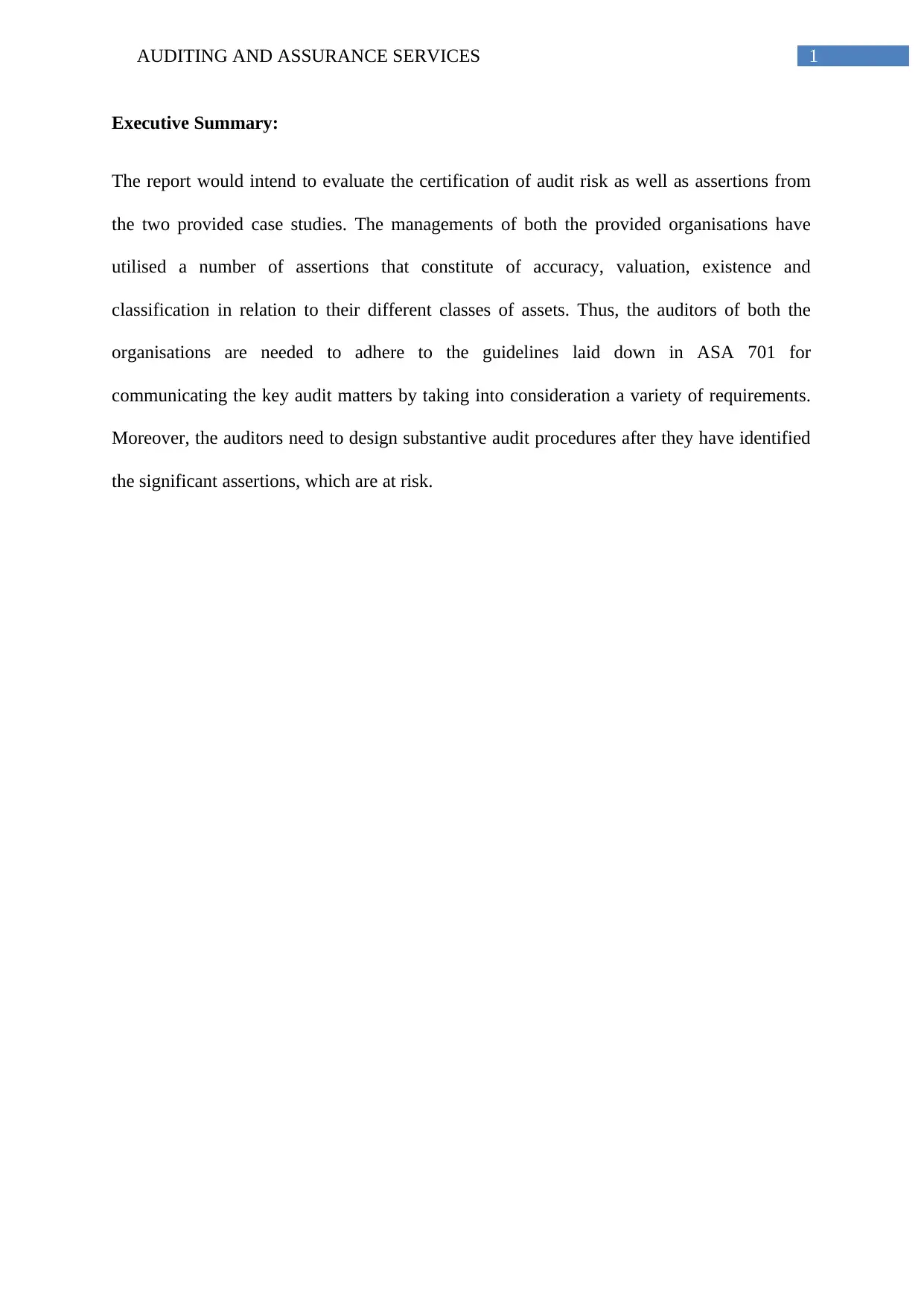
1AUDITING AND ASSURANCE SERVICES
Executive Summary:
The report would intend to evaluate the certification of audit risk as well as assertions from
the two provided case studies. The managements of both the provided organisations have
utilised a number of assertions that constitute of accuracy, valuation, existence and
classification in relation to their different classes of assets. Thus, the auditors of both the
organisations are needed to adhere to the guidelines laid down in ASA 701 for
communicating the key audit matters by taking into consideration a variety of requirements.
Moreover, the auditors need to design substantive audit procedures after they have identified
the significant assertions, which are at risk.
Executive Summary:
The report would intend to evaluate the certification of audit risk as well as assertions from
the two provided case studies. The managements of both the provided organisations have
utilised a number of assertions that constitute of accuracy, valuation, existence and
classification in relation to their different classes of assets. Thus, the auditors of both the
organisations are needed to adhere to the guidelines laid down in ASA 701 for
communicating the key audit matters by taking into consideration a variety of requirements.
Moreover, the auditors need to design substantive audit procedures after they have identified
the significant assertions, which are at risk.
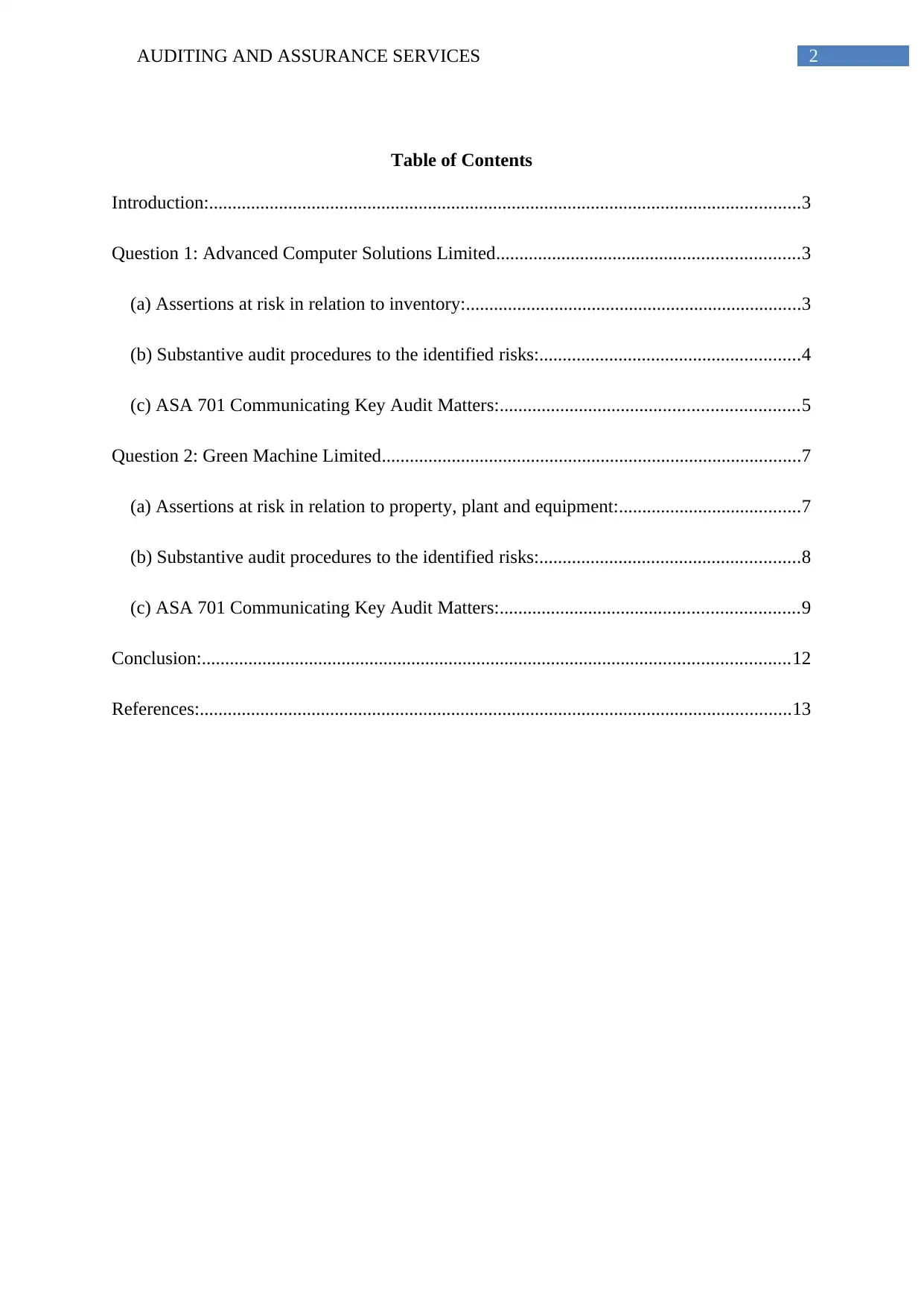
2AUDITING AND ASSURANCE SERVICES
Table of Contents
Introduction:...............................................................................................................................3
Question 1: Advanced Computer Solutions Limited.................................................................3
(a) Assertions at risk in relation to inventory:........................................................................3
(b) Substantive audit procedures to the identified risks:........................................................4
(c) ASA 701 Communicating Key Audit Matters:................................................................5
Question 2: Green Machine Limited..........................................................................................7
(a) Assertions at risk in relation to property, plant and equipment:.......................................7
(b) Substantive audit procedures to the identified risks:........................................................8
(c) ASA 701 Communicating Key Audit Matters:................................................................9
Conclusion:..............................................................................................................................12
References:...............................................................................................................................13
Table of Contents
Introduction:...............................................................................................................................3
Question 1: Advanced Computer Solutions Limited.................................................................3
(a) Assertions at risk in relation to inventory:........................................................................3
(b) Substantive audit procedures to the identified risks:........................................................4
(c) ASA 701 Communicating Key Audit Matters:................................................................5
Question 2: Green Machine Limited..........................................................................................7
(a) Assertions at risk in relation to property, plant and equipment:.......................................7
(b) Substantive audit procedures to the identified risks:........................................................8
(c) ASA 701 Communicating Key Audit Matters:................................................................9
Conclusion:..............................................................................................................................12
References:...............................................................................................................................13
⊘ This is a preview!⊘
Do you want full access?
Subscribe today to unlock all pages.

Trusted by 1+ million students worldwide
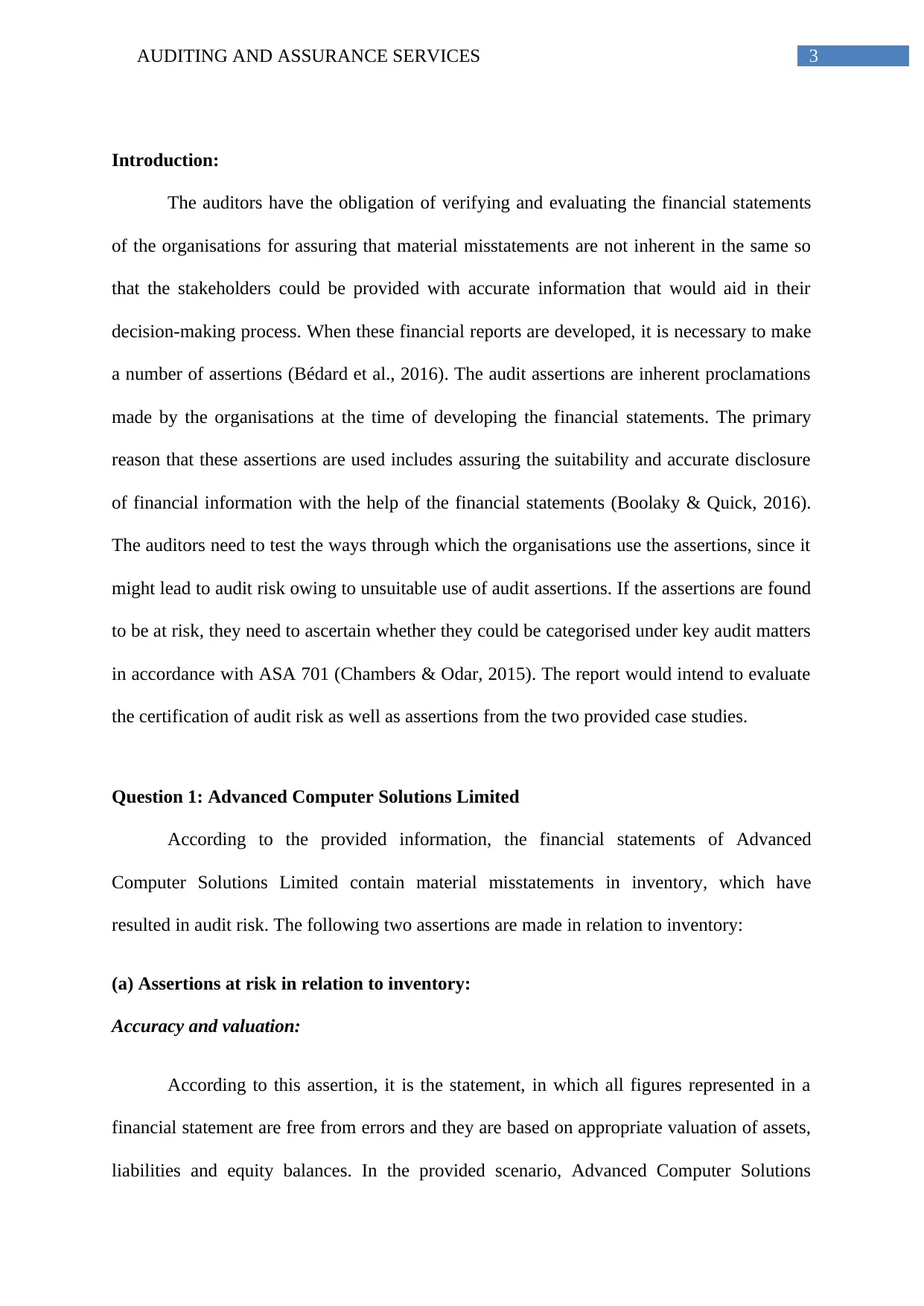
3AUDITING AND ASSURANCE SERVICES
Introduction:
The auditors have the obligation of verifying and evaluating the financial statements
of the organisations for assuring that material misstatements are not inherent in the same so
that the stakeholders could be provided with accurate information that would aid in their
decision-making process. When these financial reports are developed, it is necessary to make
a number of assertions (Bédard et al., 2016). The audit assertions are inherent proclamations
made by the organisations at the time of developing the financial statements. The primary
reason that these assertions are used includes assuring the suitability and accurate disclosure
of financial information with the help of the financial statements (Boolaky & Quick, 2016).
The auditors need to test the ways through which the organisations use the assertions, since it
might lead to audit risk owing to unsuitable use of audit assertions. If the assertions are found
to be at risk, they need to ascertain whether they could be categorised under key audit matters
in accordance with ASA 701 (Chambers & Odar, 2015). The report would intend to evaluate
the certification of audit risk as well as assertions from the two provided case studies.
Question 1: Advanced Computer Solutions Limited
According to the provided information, the financial statements of Advanced
Computer Solutions Limited contain material misstatements in inventory, which have
resulted in audit risk. The following two assertions are made in relation to inventory:
(a) Assertions at risk in relation to inventory:
Accuracy and valuation:
According to this assertion, it is the statement, in which all figures represented in a
financial statement are free from errors and they are based on appropriate valuation of assets,
liabilities and equity balances. In the provided scenario, Advanced Computer Solutions
Introduction:
The auditors have the obligation of verifying and evaluating the financial statements
of the organisations for assuring that material misstatements are not inherent in the same so
that the stakeholders could be provided with accurate information that would aid in their
decision-making process. When these financial reports are developed, it is necessary to make
a number of assertions (Bédard et al., 2016). The audit assertions are inherent proclamations
made by the organisations at the time of developing the financial statements. The primary
reason that these assertions are used includes assuring the suitability and accurate disclosure
of financial information with the help of the financial statements (Boolaky & Quick, 2016).
The auditors need to test the ways through which the organisations use the assertions, since it
might lead to audit risk owing to unsuitable use of audit assertions. If the assertions are found
to be at risk, they need to ascertain whether they could be categorised under key audit matters
in accordance with ASA 701 (Chambers & Odar, 2015). The report would intend to evaluate
the certification of audit risk as well as assertions from the two provided case studies.
Question 1: Advanced Computer Solutions Limited
According to the provided information, the financial statements of Advanced
Computer Solutions Limited contain material misstatements in inventory, which have
resulted in audit risk. The following two assertions are made in relation to inventory:
(a) Assertions at risk in relation to inventory:
Accuracy and valuation:
According to this assertion, it is the statement, in which all figures represented in a
financial statement are free from errors and they are based on appropriate valuation of assets,
liabilities and equity balances. In the provided scenario, Advanced Computer Solutions
Paraphrase This Document
Need a fresh take? Get an instant paraphrase of this document with our AI Paraphraser
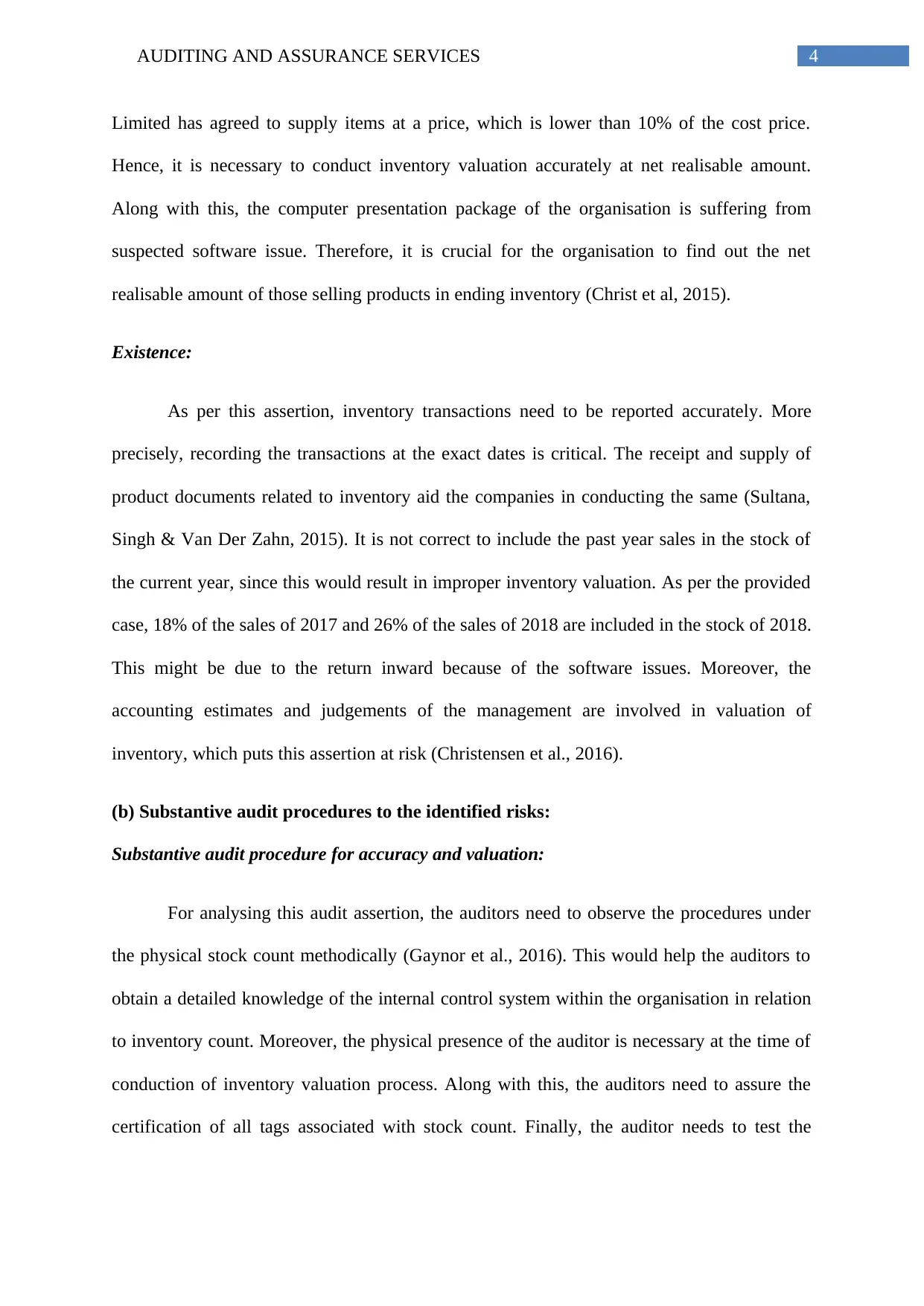
4AUDITING AND ASSURANCE SERVICES
Limited has agreed to supply items at a price, which is lower than 10% of the cost price.
Hence, it is necessary to conduct inventory valuation accurately at net realisable amount.
Along with this, the computer presentation package of the organisation is suffering from
suspected software issue. Therefore, it is crucial for the organisation to find out the net
realisable amount of those selling products in ending inventory (Christ et al, 2015).
Existence:
As per this assertion, inventory transactions need to be reported accurately. More
precisely, recording the transactions at the exact dates is critical. The receipt and supply of
product documents related to inventory aid the companies in conducting the same (Sultana,
Singh & Van Der Zahn, 2015). It is not correct to include the past year sales in the stock of
the current year, since this would result in improper inventory valuation. As per the provided
case, 18% of the sales of 2017 and 26% of the sales of 2018 are included in the stock of 2018.
This might be due to the return inward because of the software issues. Moreover, the
accounting estimates and judgements of the management are involved in valuation of
inventory, which puts this assertion at risk (Christensen et al., 2016).
(b) Substantive audit procedures to the identified risks:
Substantive audit procedure for accuracy and valuation:
For analysing this audit assertion, the auditors need to observe the procedures under
the physical stock count methodically (Gaynor et al., 2016). This would help the auditors to
obtain a detailed knowledge of the internal control system within the organisation in relation
to inventory count. Moreover, the physical presence of the auditor is necessary at the time of
conduction of inventory valuation process. Along with this, the auditors need to assure the
certification of all tags associated with stock count. Finally, the auditor needs to test the
Limited has agreed to supply items at a price, which is lower than 10% of the cost price.
Hence, it is necessary to conduct inventory valuation accurately at net realisable amount.
Along with this, the computer presentation package of the organisation is suffering from
suspected software issue. Therefore, it is crucial for the organisation to find out the net
realisable amount of those selling products in ending inventory (Christ et al, 2015).
Existence:
As per this assertion, inventory transactions need to be reported accurately. More
precisely, recording the transactions at the exact dates is critical. The receipt and supply of
product documents related to inventory aid the companies in conducting the same (Sultana,
Singh & Van Der Zahn, 2015). It is not correct to include the past year sales in the stock of
the current year, since this would result in improper inventory valuation. As per the provided
case, 18% of the sales of 2017 and 26% of the sales of 2018 are included in the stock of 2018.
This might be due to the return inward because of the software issues. Moreover, the
accounting estimates and judgements of the management are involved in valuation of
inventory, which puts this assertion at risk (Christensen et al., 2016).
(b) Substantive audit procedures to the identified risks:
Substantive audit procedure for accuracy and valuation:
For analysing this audit assertion, the auditors need to observe the procedures under
the physical stock count methodically (Gaynor et al., 2016). This would help the auditors to
obtain a detailed knowledge of the internal control system within the organisation in relation
to inventory count. Moreover, the physical presence of the auditor is necessary at the time of
conduction of inventory valuation process. Along with this, the auditors need to assure the
certification of all tags associated with stock count. Finally, the auditor needs to test the
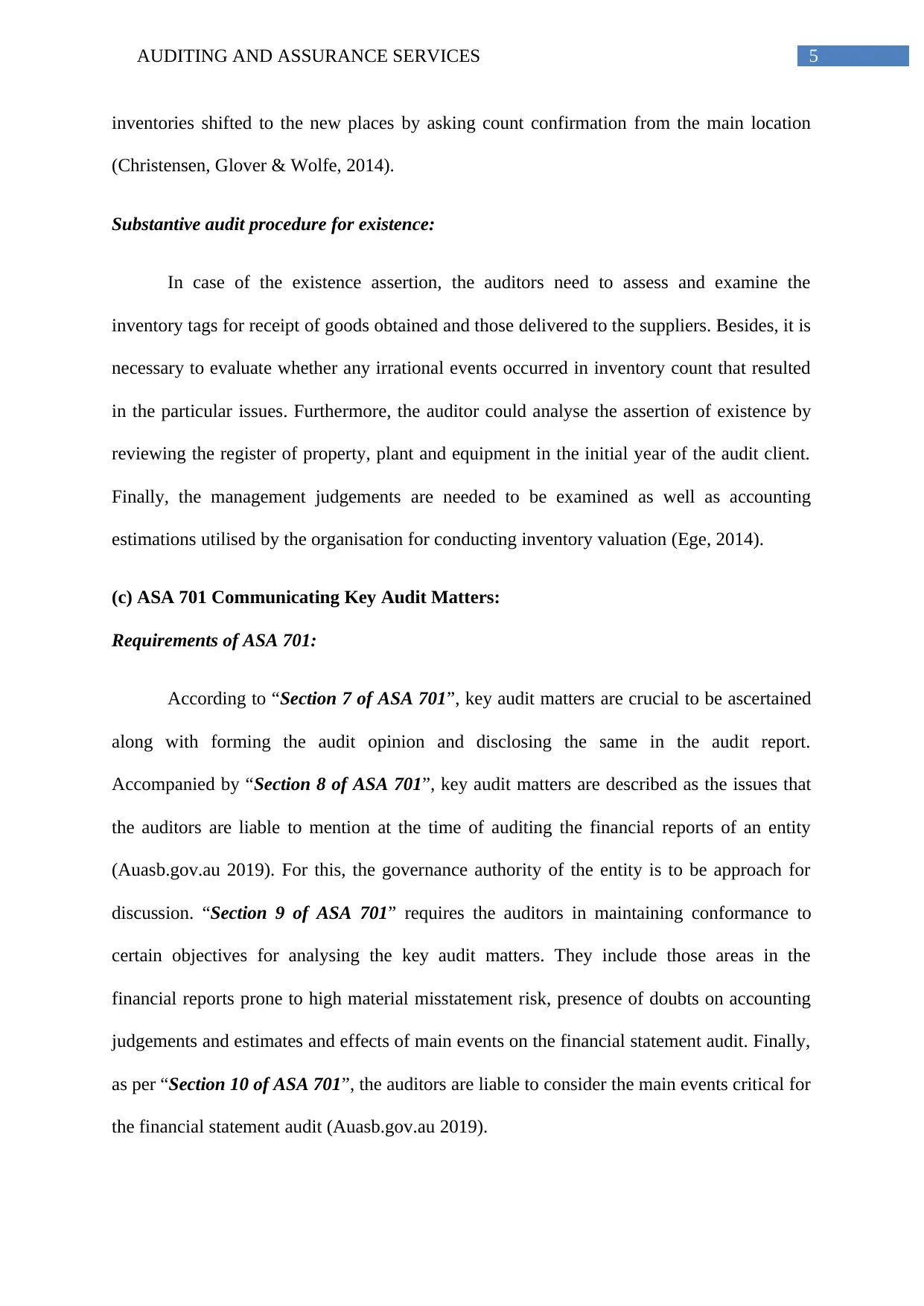
5AUDITING AND ASSURANCE SERVICES
inventories shifted to the new places by asking count confirmation from the main location
(Christensen, Glover & Wolfe, 2014).
Substantive audit procedure for existence:
In case of the existence assertion, the auditors need to assess and examine the
inventory tags for receipt of goods obtained and those delivered to the suppliers. Besides, it is
necessary to evaluate whether any irrational events occurred in inventory count that resulted
in the particular issues. Furthermore, the auditor could analyse the assertion of existence by
reviewing the register of property, plant and equipment in the initial year of the audit client.
Finally, the management judgements are needed to be examined as well as accounting
estimations utilised by the organisation for conducting inventory valuation (Ege, 2014).
(c) ASA 701 Communicating Key Audit Matters:
Requirements of ASA 701:
According to “Section 7 of ASA 701”, key audit matters are crucial to be ascertained
along with forming the audit opinion and disclosing the same in the audit report.
Accompanied by “Section 8 of ASA 701”, key audit matters are described as the issues that
the auditors are liable to mention at the time of auditing the financial reports of an entity
(Auasb.gov.au 2019). For this, the governance authority of the entity is to be approach for
discussion. “Section 9 of ASA 701” requires the auditors in maintaining conformance to
certain objectives for analysing the key audit matters. They include those areas in the
financial reports prone to high material misstatement risk, presence of doubts on accounting
judgements and estimates and effects of main events on the financial statement audit. Finally,
as per “Section 10 of ASA 701”, the auditors are liable to consider the main events critical for
the financial statement audit (Auasb.gov.au 2019).
inventories shifted to the new places by asking count confirmation from the main location
(Christensen, Glover & Wolfe, 2014).
Substantive audit procedure for existence:
In case of the existence assertion, the auditors need to assess and examine the
inventory tags for receipt of goods obtained and those delivered to the suppliers. Besides, it is
necessary to evaluate whether any irrational events occurred in inventory count that resulted
in the particular issues. Furthermore, the auditor could analyse the assertion of existence by
reviewing the register of property, plant and equipment in the initial year of the audit client.
Finally, the management judgements are needed to be examined as well as accounting
estimations utilised by the organisation for conducting inventory valuation (Ege, 2014).
(c) ASA 701 Communicating Key Audit Matters:
Requirements of ASA 701:
According to “Section 7 of ASA 701”, key audit matters are crucial to be ascertained
along with forming the audit opinion and disclosing the same in the audit report.
Accompanied by “Section 8 of ASA 701”, key audit matters are described as the issues that
the auditors are liable to mention at the time of auditing the financial reports of an entity
(Auasb.gov.au 2019). For this, the governance authority of the entity is to be approach for
discussion. “Section 9 of ASA 701” requires the auditors in maintaining conformance to
certain objectives for analysing the key audit matters. They include those areas in the
financial reports prone to high material misstatement risk, presence of doubts on accounting
judgements and estimates and effects of main events on the financial statement audit. Finally,
as per “Section 10 of ASA 701”, the auditors are liable to consider the main events critical for
the financial statement audit (Auasb.gov.au 2019).
⊘ This is a preview!⊘
Do you want full access?
Subscribe today to unlock all pages.

Trusted by 1+ million students worldwide
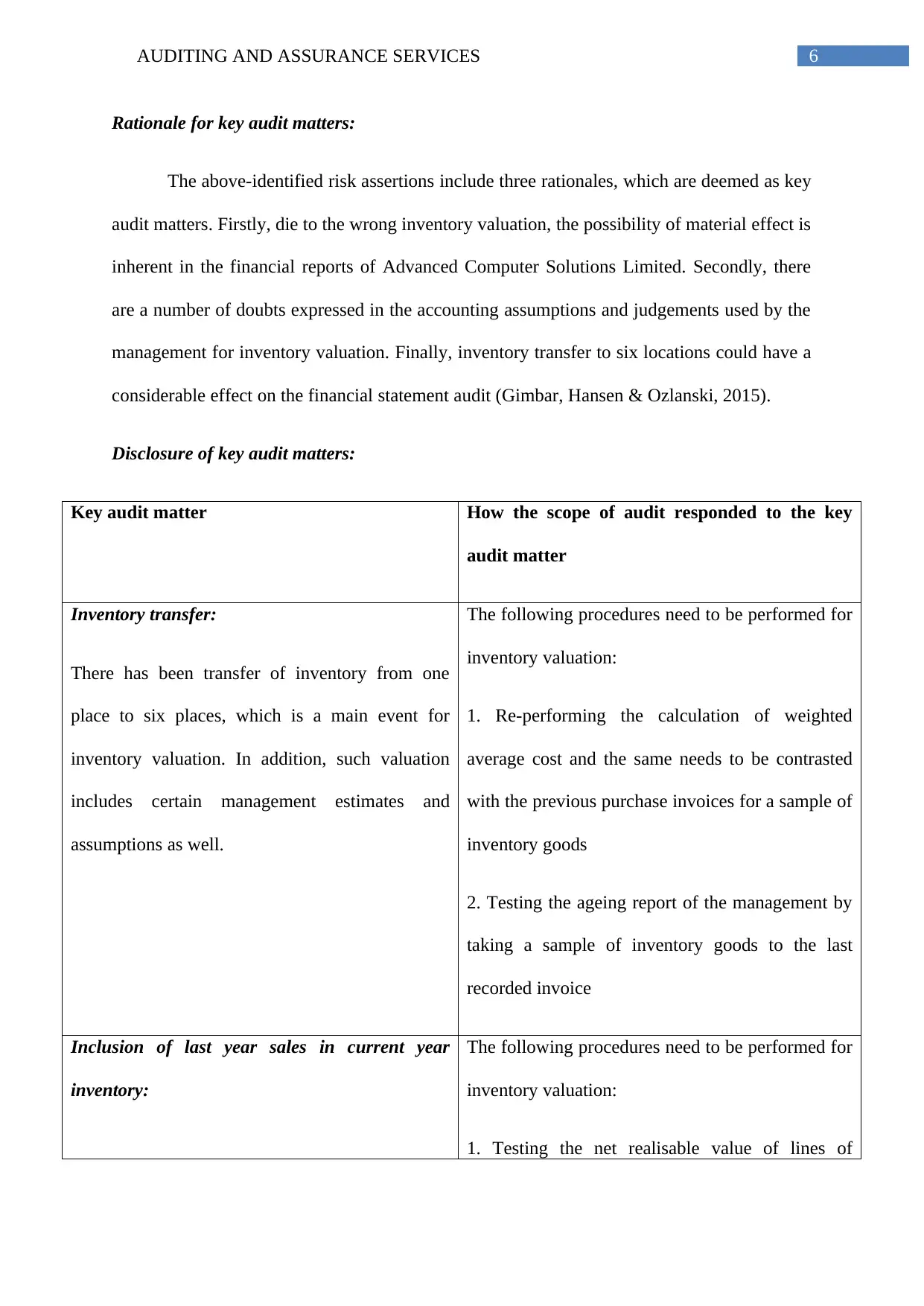
6AUDITING AND ASSURANCE SERVICES
Rationale for key audit matters:
The above-identified risk assertions include three rationales, which are deemed as key
audit matters. Firstly, die to the wrong inventory valuation, the possibility of material effect is
inherent in the financial reports of Advanced Computer Solutions Limited. Secondly, there
are a number of doubts expressed in the accounting assumptions and judgements used by the
management for inventory valuation. Finally, inventory transfer to six locations could have a
considerable effect on the financial statement audit (Gimbar, Hansen & Ozlanski, 2015).
Disclosure of key audit matters:
Key audit matter How the scope of audit responded to the key
audit matter
Inventory transfer:
There has been transfer of inventory from one
place to six places, which is a main event for
inventory valuation. In addition, such valuation
includes certain management estimates and
assumptions as well.
The following procedures need to be performed for
inventory valuation:
1. Re-performing the calculation of weighted
average cost and the same needs to be contrasted
with the previous purchase invoices for a sample of
inventory goods
2. Testing the ageing report of the management by
taking a sample of inventory goods to the last
recorded invoice
Inclusion of last year sales in current year
inventory:
The following procedures need to be performed for
inventory valuation:
1. Testing the net realisable value of lines of
Rationale for key audit matters:
The above-identified risk assertions include three rationales, which are deemed as key
audit matters. Firstly, die to the wrong inventory valuation, the possibility of material effect is
inherent in the financial reports of Advanced Computer Solutions Limited. Secondly, there
are a number of doubts expressed in the accounting assumptions and judgements used by the
management for inventory valuation. Finally, inventory transfer to six locations could have a
considerable effect on the financial statement audit (Gimbar, Hansen & Ozlanski, 2015).
Disclosure of key audit matters:
Key audit matter How the scope of audit responded to the key
audit matter
Inventory transfer:
There has been transfer of inventory from one
place to six places, which is a main event for
inventory valuation. In addition, such valuation
includes certain management estimates and
assumptions as well.
The following procedures need to be performed for
inventory valuation:
1. Re-performing the calculation of weighted
average cost and the same needs to be contrasted
with the previous purchase invoices for a sample of
inventory goods
2. Testing the ageing report of the management by
taking a sample of inventory goods to the last
recorded invoice
Inclusion of last year sales in current year
inventory:
The following procedures need to be performed for
inventory valuation:
1. Testing the net realisable value of lines of
Paraphrase This Document
Need a fresh take? Get an instant paraphrase of this document with our AI Paraphraser
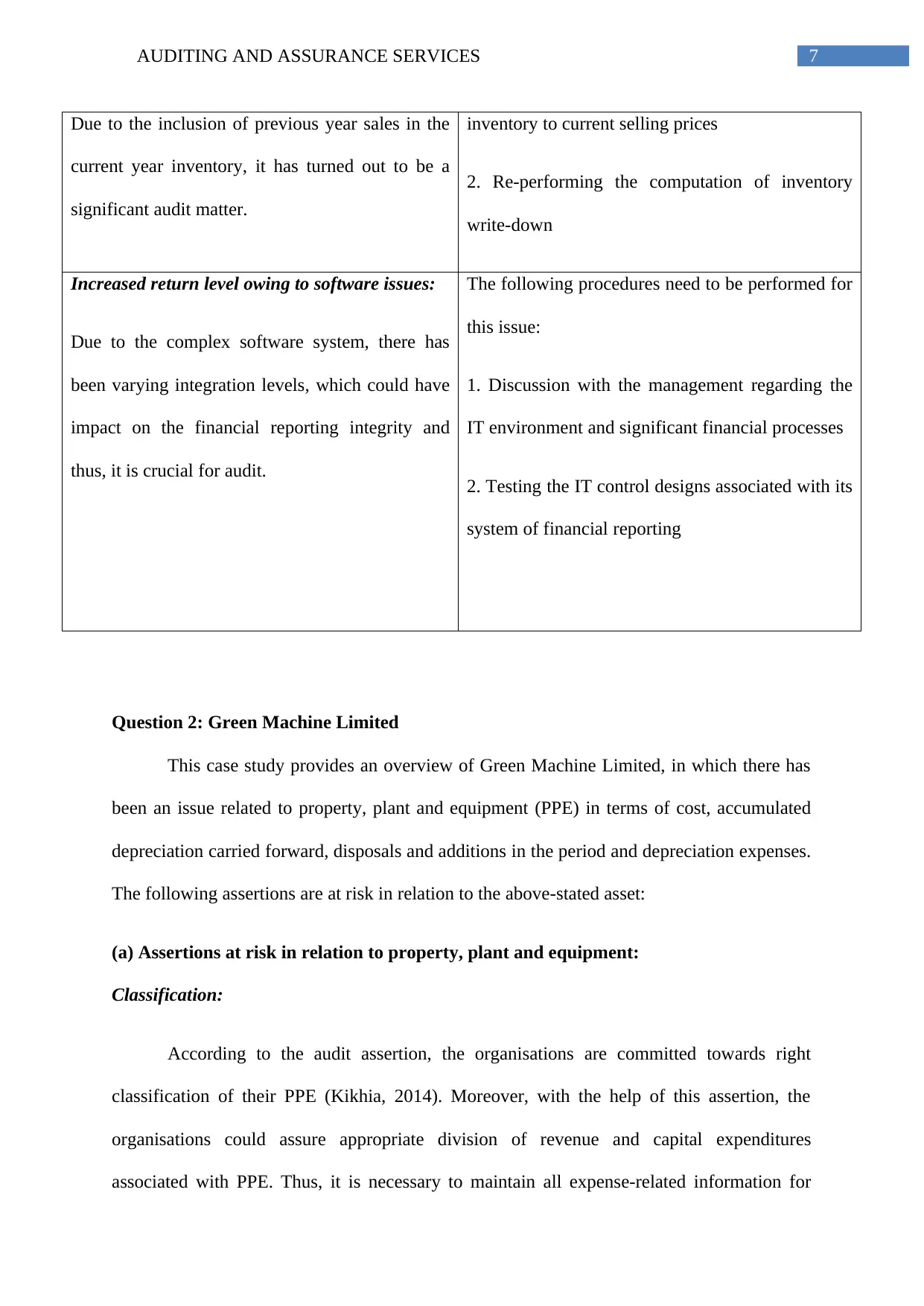
7AUDITING AND ASSURANCE SERVICES
Due to the inclusion of previous year sales in the
current year inventory, it has turned out to be a
significant audit matter.
inventory to current selling prices
2. Re-performing the computation of inventory
write-down
Increased return level owing to software issues:
Due to the complex software system, there has
been varying integration levels, which could have
impact on the financial reporting integrity and
thus, it is crucial for audit.
The following procedures need to be performed for
this issue:
1. Discussion with the management regarding the
IT environment and significant financial processes
2. Testing the IT control designs associated with its
system of financial reporting
Question 2: Green Machine Limited
This case study provides an overview of Green Machine Limited, in which there has
been an issue related to property, plant and equipment (PPE) in terms of cost, accumulated
depreciation carried forward, disposals and additions in the period and depreciation expenses.
The following assertions are at risk in relation to the above-stated asset:
(a) Assertions at risk in relation to property, plant and equipment:
Classification:
According to the audit assertion, the organisations are committed towards right
classification of their PPE (Kikhia, 2014). Moreover, with the help of this assertion, the
organisations could assure appropriate division of revenue and capital expenditures
associated with PPE. Thus, it is necessary to maintain all expense-related information for
Due to the inclusion of previous year sales in the
current year inventory, it has turned out to be a
significant audit matter.
inventory to current selling prices
2. Re-performing the computation of inventory
write-down
Increased return level owing to software issues:
Due to the complex software system, there has
been varying integration levels, which could have
impact on the financial reporting integrity and
thus, it is crucial for audit.
The following procedures need to be performed for
this issue:
1. Discussion with the management regarding the
IT environment and significant financial processes
2. Testing the IT control designs associated with its
system of financial reporting
Question 2: Green Machine Limited
This case study provides an overview of Green Machine Limited, in which there has
been an issue related to property, plant and equipment (PPE) in terms of cost, accumulated
depreciation carried forward, disposals and additions in the period and depreciation expenses.
The following assertions are at risk in relation to the above-stated asset:
(a) Assertions at risk in relation to property, plant and equipment:
Classification:
According to the audit assertion, the organisations are committed towards right
classification of their PPE (Kikhia, 2014). Moreover, with the help of this assertion, the
organisations could assure appropriate division of revenue and capital expenditures
associated with PPE. Thus, it is necessary to maintain all expense-related information for
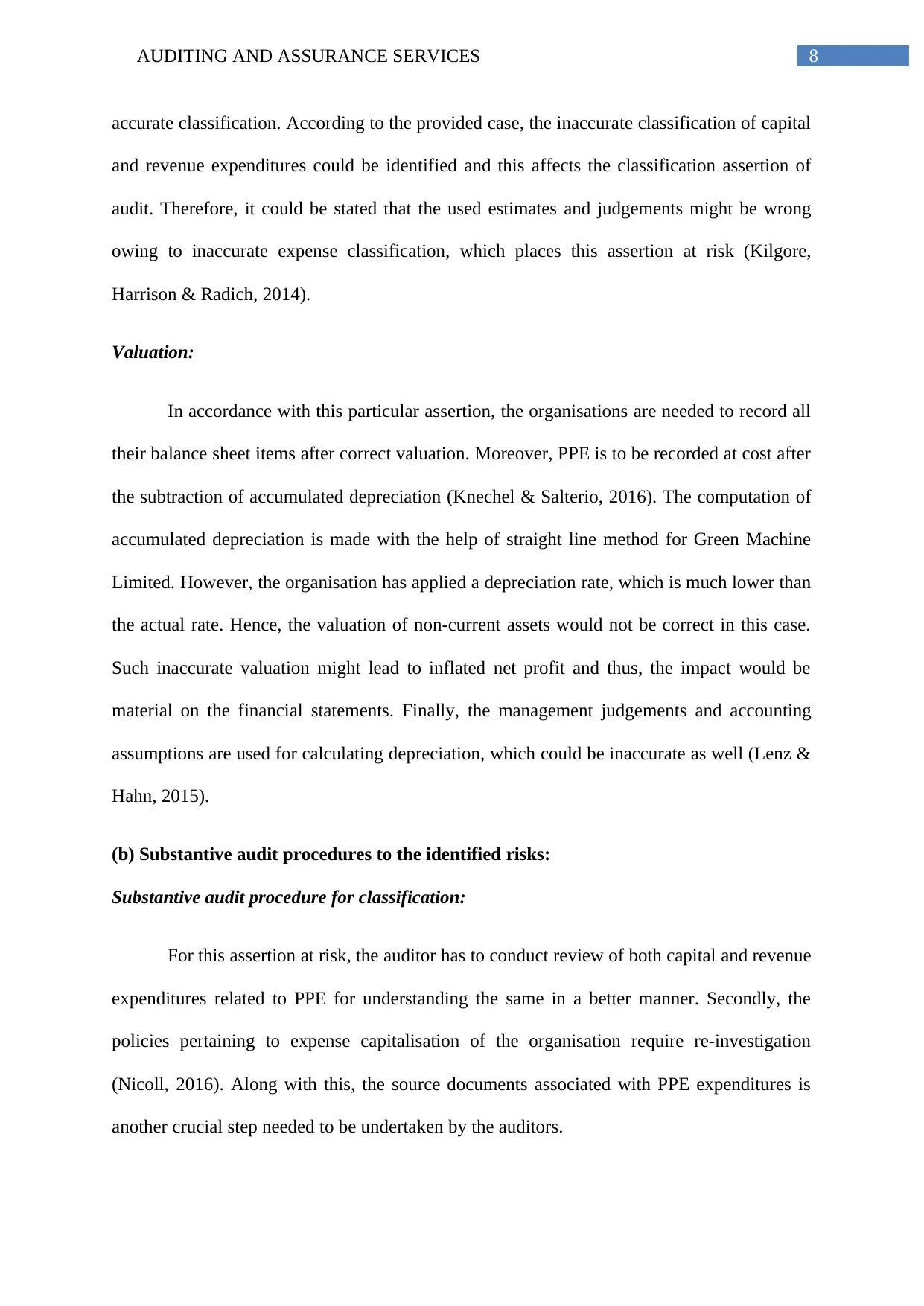
8AUDITING AND ASSURANCE SERVICES
accurate classification. According to the provided case, the inaccurate classification of capital
and revenue expenditures could be identified and this affects the classification assertion of
audit. Therefore, it could be stated that the used estimates and judgements might be wrong
owing to inaccurate expense classification, which places this assertion at risk (Kilgore,
Harrison & Radich, 2014).
Valuation:
In accordance with this particular assertion, the organisations are needed to record all
their balance sheet items after correct valuation. Moreover, PPE is to be recorded at cost after
the subtraction of accumulated depreciation (Knechel & Salterio, 2016). The computation of
accumulated depreciation is made with the help of straight line method for Green Machine
Limited. However, the organisation has applied a depreciation rate, which is much lower than
the actual rate. Hence, the valuation of non-current assets would not be correct in this case.
Such inaccurate valuation might lead to inflated net profit and thus, the impact would be
material on the financial statements. Finally, the management judgements and accounting
assumptions are used for calculating depreciation, which could be inaccurate as well (Lenz &
Hahn, 2015).
(b) Substantive audit procedures to the identified risks:
Substantive audit procedure for classification:
For this assertion at risk, the auditor has to conduct review of both capital and revenue
expenditures related to PPE for understanding the same in a better manner. Secondly, the
policies pertaining to expense capitalisation of the organisation require re-investigation
(Nicoll, 2016). Along with this, the source documents associated with PPE expenditures is
another crucial step needed to be undertaken by the auditors.
accurate classification. According to the provided case, the inaccurate classification of capital
and revenue expenditures could be identified and this affects the classification assertion of
audit. Therefore, it could be stated that the used estimates and judgements might be wrong
owing to inaccurate expense classification, which places this assertion at risk (Kilgore,
Harrison & Radich, 2014).
Valuation:
In accordance with this particular assertion, the organisations are needed to record all
their balance sheet items after correct valuation. Moreover, PPE is to be recorded at cost after
the subtraction of accumulated depreciation (Knechel & Salterio, 2016). The computation of
accumulated depreciation is made with the help of straight line method for Green Machine
Limited. However, the organisation has applied a depreciation rate, which is much lower than
the actual rate. Hence, the valuation of non-current assets would not be correct in this case.
Such inaccurate valuation might lead to inflated net profit and thus, the impact would be
material on the financial statements. Finally, the management judgements and accounting
assumptions are used for calculating depreciation, which could be inaccurate as well (Lenz &
Hahn, 2015).
(b) Substantive audit procedures to the identified risks:
Substantive audit procedure for classification:
For this assertion at risk, the auditor has to conduct review of both capital and revenue
expenditures related to PPE for understanding the same in a better manner. Secondly, the
policies pertaining to expense capitalisation of the organisation require re-investigation
(Nicoll, 2016). Along with this, the source documents associated with PPE expenditures is
another crucial step needed to be undertaken by the auditors.
⊘ This is a preview!⊘
Do you want full access?
Subscribe today to unlock all pages.

Trusted by 1+ million students worldwide
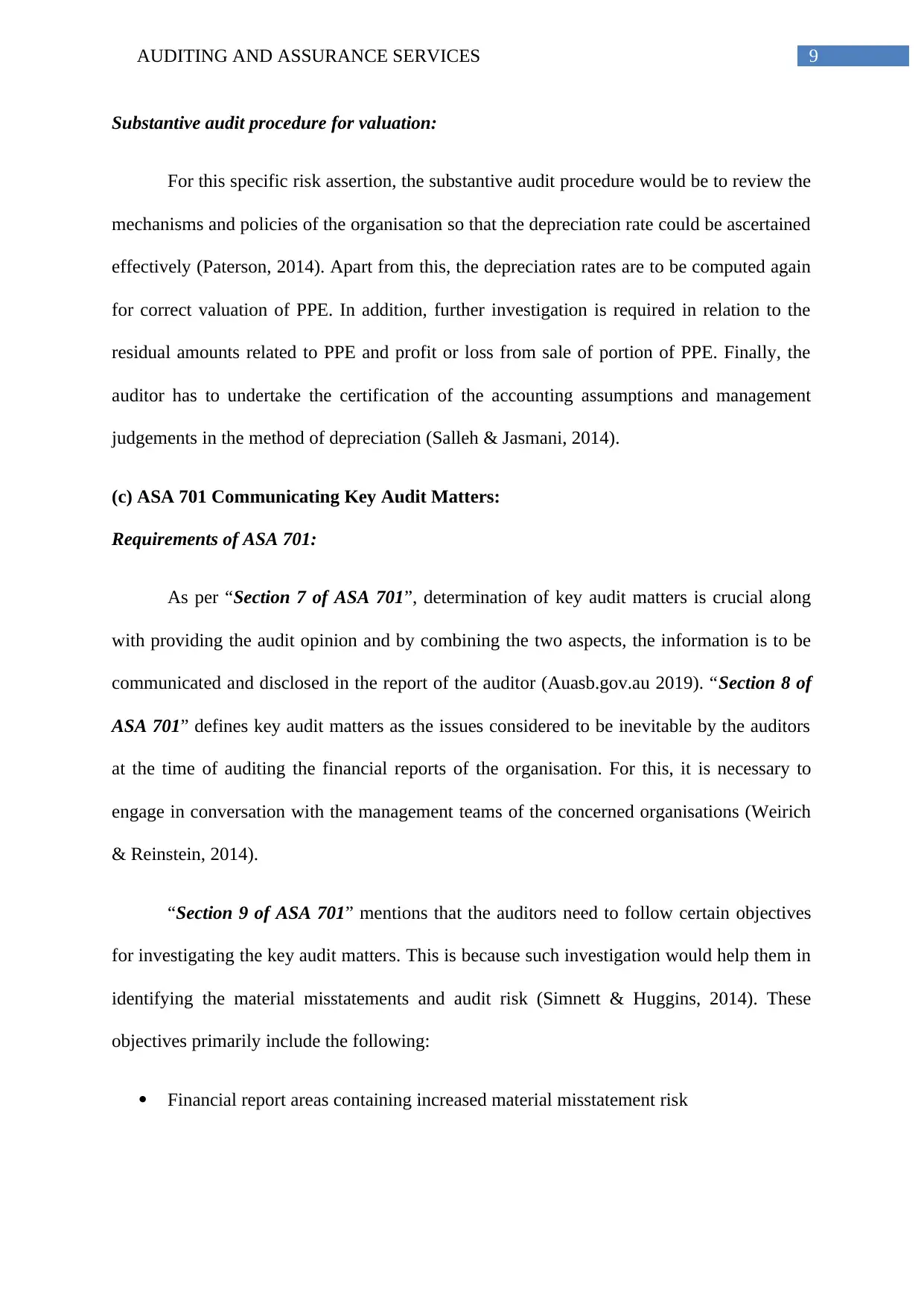
9AUDITING AND ASSURANCE SERVICES
Substantive audit procedure for valuation:
For this specific risk assertion, the substantive audit procedure would be to review the
mechanisms and policies of the organisation so that the depreciation rate could be ascertained
effectively (Paterson, 2014). Apart from this, the depreciation rates are to be computed again
for correct valuation of PPE. In addition, further investigation is required in relation to the
residual amounts related to PPE and profit or loss from sale of portion of PPE. Finally, the
auditor has to undertake the certification of the accounting assumptions and management
judgements in the method of depreciation (Salleh & Jasmani, 2014).
(c) ASA 701 Communicating Key Audit Matters:
Requirements of ASA 701:
As per “Section 7 of ASA 701”, determination of key audit matters is crucial along
with providing the audit opinion and by combining the two aspects, the information is to be
communicated and disclosed in the report of the auditor (Auasb.gov.au 2019). “Section 8 of
ASA 701” defines key audit matters as the issues considered to be inevitable by the auditors
at the time of auditing the financial reports of the organisation. For this, it is necessary to
engage in conversation with the management teams of the concerned organisations (Weirich
& Reinstein, 2014).
“Section 9 of ASA 701” mentions that the auditors need to follow certain objectives
for investigating the key audit matters. This is because such investigation would help them in
identifying the material misstatements and audit risk (Simnett & Huggins, 2014). These
objectives primarily include the following:
Financial report areas containing increased material misstatement risk
Substantive audit procedure for valuation:
For this specific risk assertion, the substantive audit procedure would be to review the
mechanisms and policies of the organisation so that the depreciation rate could be ascertained
effectively (Paterson, 2014). Apart from this, the depreciation rates are to be computed again
for correct valuation of PPE. In addition, further investigation is required in relation to the
residual amounts related to PPE and profit or loss from sale of portion of PPE. Finally, the
auditor has to undertake the certification of the accounting assumptions and management
judgements in the method of depreciation (Salleh & Jasmani, 2014).
(c) ASA 701 Communicating Key Audit Matters:
Requirements of ASA 701:
As per “Section 7 of ASA 701”, determination of key audit matters is crucial along
with providing the audit opinion and by combining the two aspects, the information is to be
communicated and disclosed in the report of the auditor (Auasb.gov.au 2019). “Section 8 of
ASA 701” defines key audit matters as the issues considered to be inevitable by the auditors
at the time of auditing the financial reports of the organisation. For this, it is necessary to
engage in conversation with the management teams of the concerned organisations (Weirich
& Reinstein, 2014).
“Section 9 of ASA 701” mentions that the auditors need to follow certain objectives
for investigating the key audit matters. This is because such investigation would help them in
identifying the material misstatements and audit risk (Simnett & Huggins, 2014). These
objectives primarily include the following:
Financial report areas containing increased material misstatement risk
Paraphrase This Document
Need a fresh take? Get an instant paraphrase of this document with our AI Paraphraser
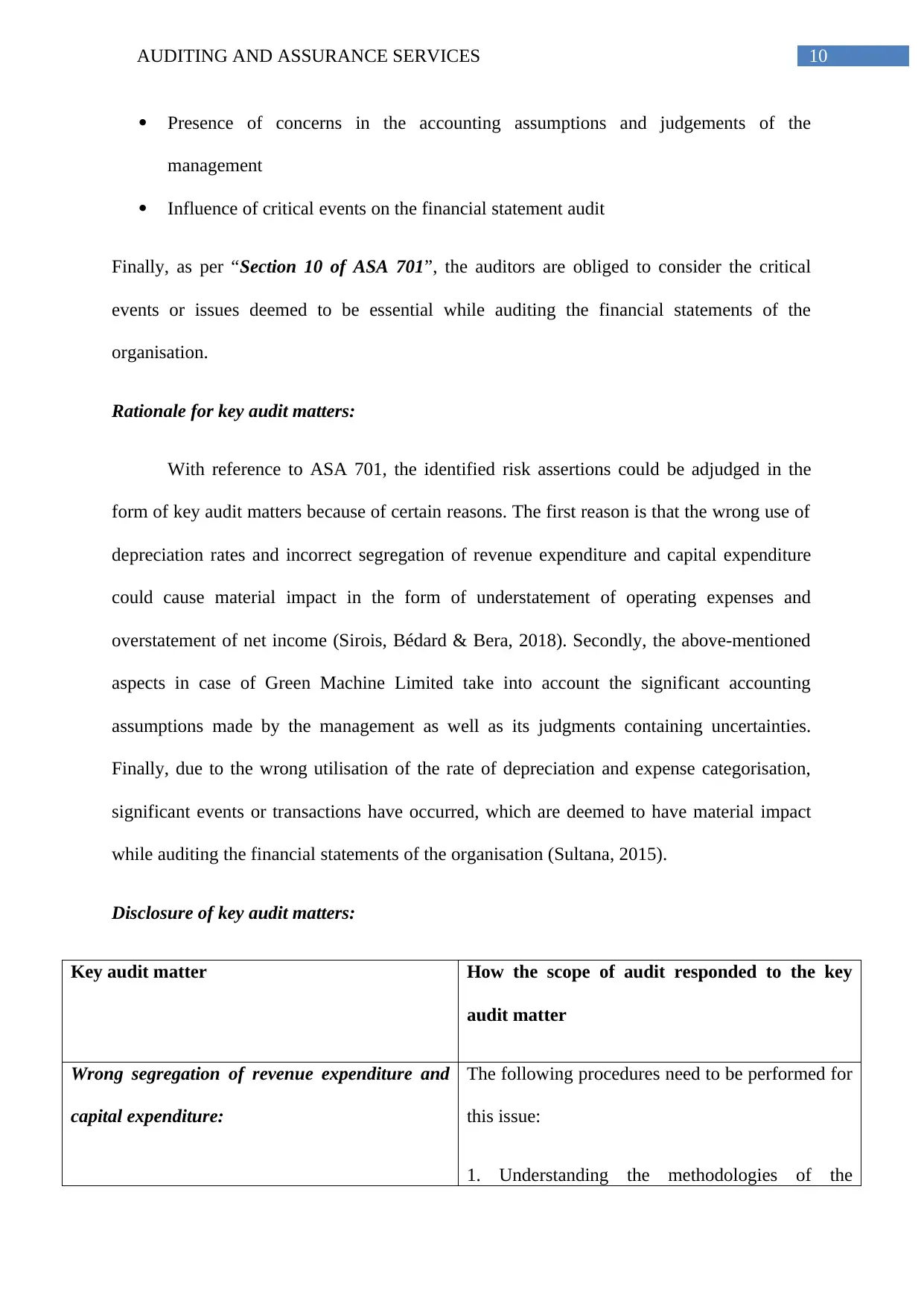
10AUDITING AND ASSURANCE SERVICES
Presence of concerns in the accounting assumptions and judgements of the
management
Influence of critical events on the financial statement audit
Finally, as per “Section 10 of ASA 701”, the auditors are obliged to consider the critical
events or issues deemed to be essential while auditing the financial statements of the
organisation.
Rationale for key audit matters:
With reference to ASA 701, the identified risk assertions could be adjudged in the
form of key audit matters because of certain reasons. The first reason is that the wrong use of
depreciation rates and incorrect segregation of revenue expenditure and capital expenditure
could cause material impact in the form of understatement of operating expenses and
overstatement of net income (Sirois, Bédard & Bera, 2018). Secondly, the above-mentioned
aspects in case of Green Machine Limited take into account the significant accounting
assumptions made by the management as well as its judgments containing uncertainties.
Finally, due to the wrong utilisation of the rate of depreciation and expense categorisation,
significant events or transactions have occurred, which are deemed to have material impact
while auditing the financial statements of the organisation (Sultana, 2015).
Disclosure of key audit matters:
Key audit matter How the scope of audit responded to the key
audit matter
Wrong segregation of revenue expenditure and
capital expenditure:
The following procedures need to be performed for
this issue:
1. Understanding the methodologies of the
Presence of concerns in the accounting assumptions and judgements of the
management
Influence of critical events on the financial statement audit
Finally, as per “Section 10 of ASA 701”, the auditors are obliged to consider the critical
events or issues deemed to be essential while auditing the financial statements of the
organisation.
Rationale for key audit matters:
With reference to ASA 701, the identified risk assertions could be adjudged in the
form of key audit matters because of certain reasons. The first reason is that the wrong use of
depreciation rates and incorrect segregation of revenue expenditure and capital expenditure
could cause material impact in the form of understatement of operating expenses and
overstatement of net income (Sirois, Bédard & Bera, 2018). Secondly, the above-mentioned
aspects in case of Green Machine Limited take into account the significant accounting
assumptions made by the management as well as its judgments containing uncertainties.
Finally, due to the wrong utilisation of the rate of depreciation and expense categorisation,
significant events or transactions have occurred, which are deemed to have material impact
while auditing the financial statements of the organisation (Sultana, 2015).
Disclosure of key audit matters:
Key audit matter How the scope of audit responded to the key
audit matter
Wrong segregation of revenue expenditure and
capital expenditure:
The following procedures need to be performed for
this issue:
1. Understanding the methodologies of the
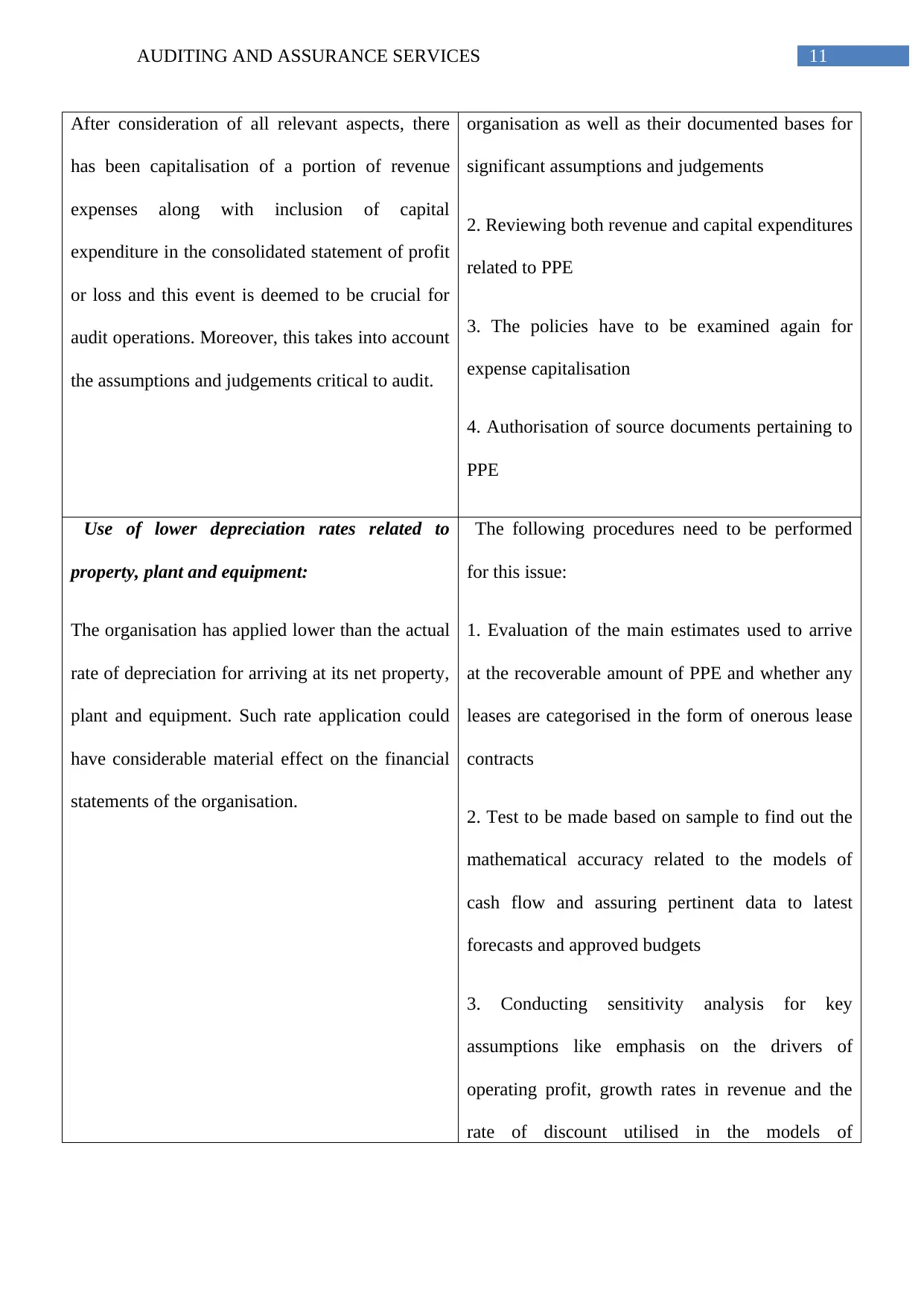
11AUDITING AND ASSURANCE SERVICES
After consideration of all relevant aspects, there
has been capitalisation of a portion of revenue
expenses along with inclusion of capital
expenditure in the consolidated statement of profit
or loss and this event is deemed to be crucial for
audit operations. Moreover, this takes into account
the assumptions and judgements critical to audit.
organisation as well as their documented bases for
significant assumptions and judgements
2. Reviewing both revenue and capital expenditures
related to PPE
3. The policies have to be examined again for
expense capitalisation
4. Authorisation of source documents pertaining to
PPE
Use of lower depreciation rates related to
property, plant and equipment:
The organisation has applied lower than the actual
rate of depreciation for arriving at its net property,
plant and equipment. Such rate application could
have considerable material effect on the financial
statements of the organisation.
The following procedures need to be performed
for this issue:
1. Evaluation of the main estimates used to arrive
at the recoverable amount of PPE and whether any
leases are categorised in the form of onerous lease
contracts
2. Test to be made based on sample to find out the
mathematical accuracy related to the models of
cash flow and assuring pertinent data to latest
forecasts and approved budgets
3. Conducting sensitivity analysis for key
assumptions like emphasis on the drivers of
operating profit, growth rates in revenue and the
rate of discount utilised in the models of
After consideration of all relevant aspects, there
has been capitalisation of a portion of revenue
expenses along with inclusion of capital
expenditure in the consolidated statement of profit
or loss and this event is deemed to be crucial for
audit operations. Moreover, this takes into account
the assumptions and judgements critical to audit.
organisation as well as their documented bases for
significant assumptions and judgements
2. Reviewing both revenue and capital expenditures
related to PPE
3. The policies have to be examined again for
expense capitalisation
4. Authorisation of source documents pertaining to
PPE
Use of lower depreciation rates related to
property, plant and equipment:
The organisation has applied lower than the actual
rate of depreciation for arriving at its net property,
plant and equipment. Such rate application could
have considerable material effect on the financial
statements of the organisation.
The following procedures need to be performed
for this issue:
1. Evaluation of the main estimates used to arrive
at the recoverable amount of PPE and whether any
leases are categorised in the form of onerous lease
contracts
2. Test to be made based on sample to find out the
mathematical accuracy related to the models of
cash flow and assuring pertinent data to latest
forecasts and approved budgets
3. Conducting sensitivity analysis for key
assumptions like emphasis on the drivers of
operating profit, growth rates in revenue and the
rate of discount utilised in the models of
⊘ This is a preview!⊘
Do you want full access?
Subscribe today to unlock all pages.

Trusted by 1+ million students worldwide
1 out of 16
Related Documents
Your All-in-One AI-Powered Toolkit for Academic Success.
+13062052269
info@desklib.com
Available 24*7 on WhatsApp / Email
![[object Object]](/_next/static/media/star-bottom.7253800d.svg)
Unlock your academic potential
Copyright © 2020–2025 A2Z Services. All Rights Reserved. Developed and managed by ZUCOL.





